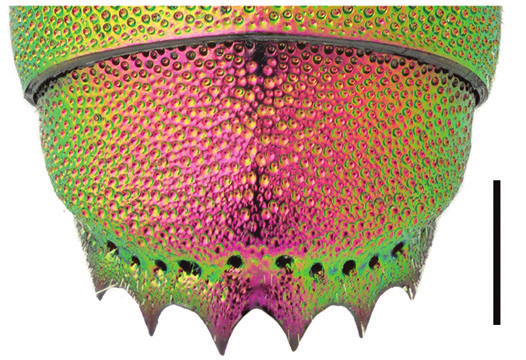Chrysis sexdentata
- Innhold
- Diagnosis
- Distribution
- Biology
Diagnosis
Figure 81
T3, dorsal view: C. sexdentata ♀. Scale 1 mm.
Length 7–11 mm.
The species is easily recognised due to its unique combination of a red metasoma and six apical teeth. The head and the mesosoma are greenish, dark blue or nearly black with coppery reflections, whereas the metasoma is dorsally purple-red or coppery red. The tergites are coarsely punctured, and the posterior margin of T3 has six sharp teeth (Fig. 81). The shape of the body is robust and compact.
Distribution
Latvia. Very rare. Only one male specimen is known from central Latvia (Ropaži, 1.VI.1961, leg. V. Tumšs) (Tumšs and Maršakovs 1970).
Trans-Palearctic: from Europe and northern Africa to western and central Asia (Linsenmaier 1959, 1999).
Biology
Habitat: gardens with dead wood, old brick walls, old fences and/or stones (Trautmann 1927, 1930). Adults occasionally visit flowers of Apiaceae and Euphorbiaceae (Linsenmaier 1997, Rosa 2004).
Flight period: June to July.
Host: Euodynerus dantici (Rossi) (Martynova and Fateryga 2015) and possibly also Ancistrocerus parietum (Linnaeus) (Vespidae) (Mocsáry 1912, Berland and Bernard 1938). Host records implicating solitary bees (e.g. Osmia brevicornis (Fabricius), O. caerulescens (Linnaeus), Hoplitis adunca (Panzer) and Megachile sicula (Rossi)) (Trautmann 1927) are dubious, as pointed out by Kunz (1994).
